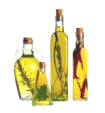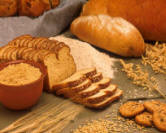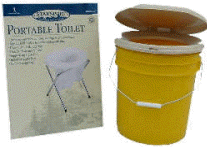|
A hundred years ago, people didn't generally go to a store very often. The South was much more agrarian than it is today, with Southerners growing the majority of the plants and animals they ate. Today many people would panic after just a few days of not being able to go to a grocery store. It is a good guess that every family will have at least one crisis in their lifetime - during that time a family should not have to worry about what they are going to eat.
The following guidelines will help in purchasing and storing basic food items for pantries.
|
|
Non-Fat Dry Milk/Dairy Products |
Powdered milk may be purchased in both instant and regular forms. There is no nutritional difference between the two forms, and the storage life is equivalent.
Buy "extra" grade "low heat" powder. It should have been dried using a "low heat spray process". It should ideally also have been fortified with vitamins A and D.
Dry milk should be stored in a tightly covered container and stored in a cool, dry, and dark location up off the floor. Dry milk must be rotated, even if you package and store it correctly. Dry milk will store well at 40oF. for 36- 60 months and at 70oF. for 12-24 months. Dry milk will store longer when packed in vacuum or nitrogen.
Other dairy products which may be stored include: canned evaporated milk, canned baby formula, powdered baby formula, cream substitutes, cheese spreads, brick cheese, powdered cheese, margarine, butter, powdered butter, dried eggs.
|
White sugar, brown sugar, powdered sugar, corn syrup and honey may be stored.
Honey kept for many months may darken slowly and become stronger in flavor but will still be usable. Honey and corn syrup may crystallize as they get older, but may be melted over hot water for use. The Honey Association recommends that infants under one year old should not be given honey because it is a raw product and may contain naturally occurring bacteria their systems cannot handle.
You may also wish to store jams and preserves, flavored gelatin and pudding mixes, powdered drink mixes, sweet toppings and syrups, candy, and soft drinks.
|

Twenty pounds of fats or oils per person should be stored for one year (1 gallon equals 7 pounds). Soybeans, flax, safflower, sunflower, and caster beans are examples of crops which are grown primarily for their oil. Most cooking oils and shortenings will store for two to three years if kept in a cool dark, dry location. Olive oil and corn oil are also very good storage oils and have a better flavor then soybean and safflower oils. Fats and oils may be stored in the following forms: cooking oil (vegetable oil), shortening, butter (fresh and dried), margarine or margarine powder, mayonnaise, salad oils and dressings including dried mixes
|
Iodized salt is best as it will help in proper functioning of the thyroid gland. Pickling salt may also be stored for bottling pickles and rock salt for making ice cream. Store salt in its original container in a dry cool, dark location and it will keep indefinitely.
|
Beans, peas, lentils, etc. provide an economical substitute for meat or other animal protein. The packaged beans, which are on the grocery shelf, are normally the highest grades. Dry beans are an easily stored food. They should be kept in a tightly covered, metal, glass, or plastic container in a dark, dry and cool location. The quality should be good for many years when stored under these conditions. Older beans will require longer soaking and cooking periods than freshly harvested beans.
Varieties of beans that may be stored are navy, pinto, kidney, black, lima, garbanzo, black-eyed peas, split peas, lentils and soybeans.
Textured vegetable protein (TVP) is a vegetable protein made from soybeans, but its texture is similar to that of meat. When used with meat, good quality TVP absorbs the flavor and is difficult to distinguish from the meat. It can be bought as unflavored or flavored (beef, ham, bacon, or chicken). Shelf-life is two to three years. As it ages, it becomes stale.
|
|
Vitamin and Mineral Supplements |
It is recommended that 365 vitamin or vitamin/mineral tablets or capsules be stored for each family member to help compensate for possible deficiencies in the diet due to a lack of variety of foods, and because of vitamins lost during food processing, storage, and preparation. Shelf-life is about three to five years if stored in a cool, dry and dark location. Despite careful food planning, women may still need an iron and calcium supplement, particularly if they are pregnant or nursing.
Storage of iron and calcium should be carefully considered.
|
Buy dark hard winter or dark hard spring wheat. (Investigate new breeds). Buy #2 grade or better. Protein content should be from 12-15 percent. Moisture content should be 10% or less. The wheat should be clean and free from living insects and foreign matter.

After purchase, the wheat should be placed in a sturdy, moisture proof container:
a 5 gallon airtight metal container with a tight fitting Grains (wheat, rice or cereals) = 300 lbs.
Powdered milk (nonfat) = 75 lbs.
Sugar or honey = 60 lbs.
Beans & legumes = 60 lbs.
Cooking oil or shortening = 20 lbs.
Salt = 5 lbs.
Double-friction lid (seal is the same as a paint can) is a good container. Sturdy poly-ethylene plastic buckets with tight fitting lids are also acceptable for wheat storage. Don't store wheat directly on concrete floors. Keep cool and dry and away from steam, water pipes, un-vented clothes dryer, wet clothes, etc.
Wheat should be treated at time of storage to guard against hatching of insect eggs. If the wheat is stored in an airtight container, it may be treated with dry ice. Drop a piece (Not pulverized) of dry ice (one-fourth pound per 5- gallon container) in the container and pour the wheat on top of it. Place the lid on, but not tightly, for five to six hours; then tighten the lid to be airtight.
Other grains to consider storing are rye, corn, barley, millet, rice, and oats. Pasta products can be counted in your grain quota.
Uncooked milled rice (white, par-boiled, and precooked) keeps indefinitely without refrigeration. Because of the oil in it's bran layers, brown rice has a shelf life of only about six months. Refrigerator or freezer storage is recommended. Cooked rice may be stored in the refrigerator for up to one week or in the freezer for six months.
Flour should never be stored by apples, onions, potatoes, etc. as it will absorb moisture from them causing it to spoil more quickly and it will also take up their flavors.
Use heavy plastic containers with tight-fitting lids. Metal containers, which may corrode, tend to give water an unpleasant taste.
If you have any doubt as to the bacterial safety of stored water, you may purify it by boiling vigorously for one to two minutes or by adding chlorine bleach (5 percent sodium hypochlorite solution). Generally, half a tsp. of bleach will purify five gallons of clear water, and one tsp. Will purify five gallons of cloudy water. If you store it away from sunlight in clean containers, and if it is safe bacterially at the time of storage, water will remain pure indefinitely. Households should routinely store enough water in advance to last at least 3 days. Allow one gallon of water per person/per day for drinking and additional water for family pets. Drinking water should be stored in food-grade plastic containers and kept in a cool, dark place. Consumers may bottle their own emergency water supply in sterilized containers with tight-fitting lids or purchase commercially bottled water. Commercially bottled water (sealed and air-tight), has a one-year shelf life. Home-bottled water can be stored for six months. In either case, stored water should be dated and replaced at appropriate intervals. (Once expired, the water is safe to use on indoor or outdoor plants.)
If you don't have an emergency water supply on hand and find yourself without water, you can take these steps to disinfect the water in your hot water heater:
 
Open the water heater using the spigot at the bottom.
Strain the water through a clean cloth to remove any sediment
Mix the water with a household chlorine bleach (5.25% sodium hypochlorite solution. Do not use bleach solutions containing perfumes or colors.)
For one gallon of clear water, use 8 drops of bleach; for cloudy water, use 16 drops.
Let the water stand for 30 minutes.
If you do not smell a slight chlorine odor, repeat the disinfection process.
|
Emergency Chemical Toilet 
The following items should be stored together inside a 5-gallon plastic bucket (with tight fitting lid)
2 large boxes of garbage can liners (30 gallon size)
1 gallon liquid chlorine bleach or other chemical
Pinesol®
6-8 rolls toilet paper
feminine sanitary supplies
2 boxes baking soda
2 boxes trash can liners (8-10 gallon size)
paper towels
The bucket will serve as the toilet during an emergency. To use this toilet simply remove the contents from the bucket, insert a large plastic garbage can liner into the bucket and fold the edges over the rim of the bucket. Mix one cup of liquid chlorine bleach to one-half gallon of water (one to ten ratio--do not use dry or powdered bleach as it is caustic and not safe for this type of use) and pour this solution into the bucket. This will kill germs and insure adequate coverage. Though the bucket may be somewhat uncomfortable to sit upon, it certainly beats the alternative.
After each usage replace the lid securely upon the bucket to keep insects out and to keep the smell contained. When the bucket is one-third to one-half full, tie the garbage bag liner shut and dispose of it appropriately (i.e., burying it, placing it inside a large covered metal garbage can for later disposal, or placing it in an approved disposal location). Put another liner inside the bucket and continue as above.
Other chemicals that can be used in place of liquid chlorine bleach are: HTH (calcium hypochlorite), which is available at swimming pool supply stores and is intended to be used in solution. Following the directions on the package it can be mixed and stored.
Caution: Do not use calcium hypochlorite to disinfect drinking water as it kills all the beneficial bacteria in the intestinal tract and thus causes mild diarrhea.
Portable toilet chemicals, both liquid and dry, are available at recreational vehicle (RV) supply stores. These chemicals are designed especially for toilets which are not connected to sewer lines. Use according to package directions. Powdered, chlorinated lime is available at building supply stores. It can be used dry. Be sure to get chlorinated lime, not quick lime which is highly alkaline and corrosive.
Caution: Chlorinated products which are intended to be mixed with water for use can be dangerous if used dry. You may also use powdered laundry detergent, Lysol, Pinesol, ammonia, or other household cleaning and disinfecting products. Where radioactive fallout does not present a hazard, a temporary pit privy may be constructed in the yard for use by several families. This offers a good method of waste disposal over extended periods of time.
The structure need not be elaborate, so long as it provides reasonable privacy and shelter. The pit should be made fly-proof by means of a tight-fitting riser, seat, and cover. A low mound of earth should be tamped around the base of the privy to divert surface drainage and help keep the pit dry. Accumulated waste should be covered with not less than 12 inches of earth when the privy is moved or abandoned.
Persons in city apartments, office buildings, or homes without yards should keep a supply of waterproof containers on hand for emergency waste disposal.
Homemade soil bags may also be used and are easily made by putting one large grocery bag inside another, with a layer of shredded newspaper or other absorbent material between. Apartment dwellers should have sufficient grocery bags on hand for possible emergencies. If you have a baby in your home, it is best to keep an ample supply of disposable diapers on hand for emergency use. If these are not available, emergency diaper needs can be met by lining rubber pants with cleansing tissue, toilet paper, scraps of cloth, or other absorbent materials.
To help insure proper sanitation it is imperative that you store a sufficient supply of disposable diapers, disposable wipes, and plastic garbage can liners. Change infants and toddlers regularly and keep them clean. Dispose of the soiled diapers in the plastic garbage can liners and keep them tightly sealed when not in use to help prevent the spread of disease.
Be sure to wash your own hands regularly when working with infants (especially after each diaper change). Typhoid fever, amoebic dysentery, diarrhea, infectious hepatitis, salmonella and Giardiasis are diseases that spread rapidly in times of emergency and threaten all, yet are all diseases that can easily be controlled by simply following the rules of good sanitation.
|
|